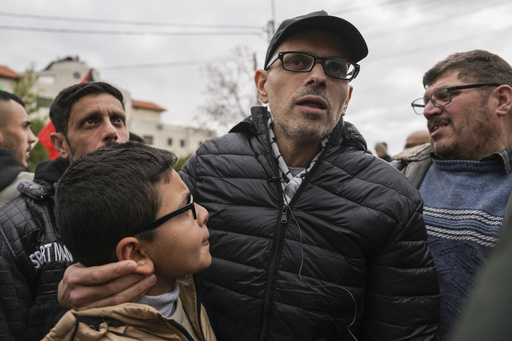RAMALLAH, West Bank — Israel announced the release of 183 Palestinian detainees on Saturday, marking a significant development in recent negotiations regarding Israeli hostages held in Gaza. This release is part of a temporary ceasefire that has halted ongoing conflict, though uncertainty lingers about the agreement’s longevity.
Israel classifies these individuals as terrorists, while Palestinians regard them as freedom fighters combating a prolonged military presence. Many Palestinians have a personal connection to someone imprisoned by Israel, whether for militant activities or actions considered minor offenses, such as protesting or being part of banned political groups. Numerous individuals are held indefinitely without trial under what Israel refers to as administrative detention, justified by the government as a necessary measure for security and to safeguard sensitive information.
Among those released, 18 were serving life sentences, and an additional 54 had lengthy terms for their roles in violent attacks against Israelis. Many of these individuals had spent decades incarcerated. In Beitunia, cheers and whistles accompanied the returning prisoners, who were welcomed as heroes, proudly waving flags and expressing solidarity with Hamas.
Numerous released men expressed their emotions profoundly, kneeling in gratitude as they stepped off the transportation, overwhelmed by the return to their families and communities across the West Bank. “We’ve waited a long time for this. The waiting is unbearable,” said Samah Abu Aliya, whose son, Imad, was released after a four-and-a-half-year sentence. “Now we look toward the future and hope for more releases.”
Seven of those convicted of the most serious offenses were transferred to Egypt, where they will either remain or be sent to other locations as part of the ceasefire terms. Furthermore, 111 detainees from Gaza, who were captured after the October 7, 2023, assaults on southern Israel that initiated the current conflict, were also released without trial. Celebrations erupted in Khan Younis, Gaza, as many flooded the streets in response to this development.
Example profiles of significant Palestinian prisoners released during this time illustrate the complexity of the situation. Iyad Abu Shakhdam, 49, was sentenced to 18 life terms for his involvement in attacks that led to numerous Israeli casualties, including a notorious bus bombing in 2004. Upon his release, he expressed relief and determination about returning to his community.
Another notable figure, Jamal al-Tawil, 61, had previously been a pivotal Hamas political leader and spent extensive periods in and out of prisons due to his affiliations. Following his most recent arrest in 2021, he endured a lengthy hunger strike protesting his detention without charge. His daughter, a journalist, advocated for his release on social media amidst warnings from the Israeli forces.
Mohammed el-Halabi, who managed the Gaza branch of World Vision, was convicted in a highly publicized case of misappropriating substantial funds intended for humanitarian purposes. He maintained his innocence throughout the legal process, facing accusations characterized by rights organizations as unfair and marred by a lack of transparency.
Additional profiles shed light on more prisoners, such as Shadi Amouri, who faced convictions for involvement in lethal attacks during the intifada, and notable former militants like Zakaria Zubeidi and Mohammed Abu Warda, both of whom have complex legacies tied to resistance against Israeli actions.
As negotiations proceed, the reactions from families and supporters reflect the tension and hope intertwined in this deeply rooted conflict. Celebrations emerged amidst the releases, highlighting the symbolism of freedom and the ongoing struggle for justice among Palestinian communities. The broader implications for peace and the future of these negotiations remain a focal point in the region’s ongoing narrative.
